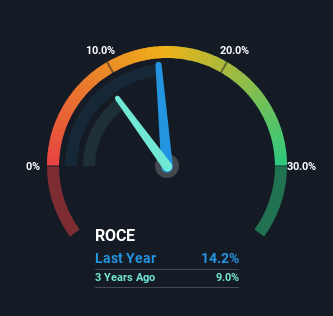PUMA (ETR:PUM) Has More To Do To Multiply In Value Going Forward
To find a multi-bagger stock, what are the underlying trends we should look for in a business? One common approach is to try and find a company with returns on capital employed (ROCE) that are increasing, in conjunction with a growing amount of capital employed. Basically this means that a company has profitable initiatives that it can continue to reinvest in, which is a trait of a compounding machine. With that in mind, the ROCE of PUMA (ETR:PUM) looks decent, right now, so lets see what the trend of returns can tell us.
What Is Return On Capital Employed (ROCE)?
Just to clarify if you're unsure, ROCE is a metric for evaluating how much pre-tax income (in percentage terms) a company earns on the capital invested in its business. To calculate this metric for PUMA, this is the formula:
Return on Capital Employed = Earnings Before Interest and Tax (EBIT) ÷ (Total Assets - Current Liabilities)
0.14 = €596m ÷ (€6.8b - €2.6b) (Based on the trailing twelve months to March 2024).
So, PUMA has an ROCE of 14%. That's a relatively normal return on capital, and it's around the 12% generated by the Luxury industry.
View our latest analysis for PUMA
In the above chart we have measured PUMA's prior ROCE against its prior performance, but the future is arguably more important. If you'd like, you can check out the forecasts from the analysts covering PUMA for free.
How Are Returns Trending?
While the returns on capital are good, they haven't moved much. The company has consistently earned 14% for the last five years, and the capital employed within the business has risen 57% in that time. 14% is a pretty standard return, and it provides some comfort knowing that PUMA has consistently earned this amount. Stable returns in this ballpark can be unexciting, but if they can be maintained over the long run, they often provide nice rewards to shareholders.
What We Can Learn From PUMA's ROCE
In the end, PUMA has proven its ability to adequately reinvest capital at good rates of return. However, over the last five years, the stock hasn't provided much growth to shareholders in the way of total returns. That's why we think it'd be worthwhile to look further into this stock given the fundamentals are appealing.
If you want to continue researching PUMA, you might be interested to know about the 1 warning sign that our analysis has discovered.
While PUMA isn't earning the highest return, check out this free list of companies that are earning high returns on equity with solid balance sheets.
Have feedback on this article? Concerned about the content? Get in touch with us directly. Alternatively, email editorial-team (at) simplywallst.com.
This article by Simply Wall St is general in nature. We provide commentary based on historical data and analyst forecasts only using an unbiased methodology and our articles are not intended to be financial advice. It does not constitute a recommendation to buy or sell any stock, and does not take account of your objectives, or your financial situation. We aim to bring you long-term focused analysis driven by fundamental data. Note that our analysis may not factor in the latest price-sensitive company announcements or qualitative material. Simply Wall St has no position in any stocks mentioned.

 Yahoo Finance
Yahoo Finance 
